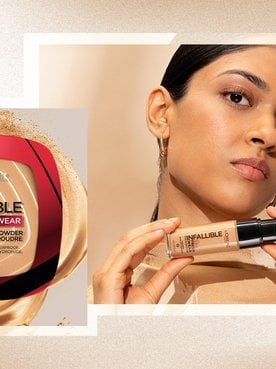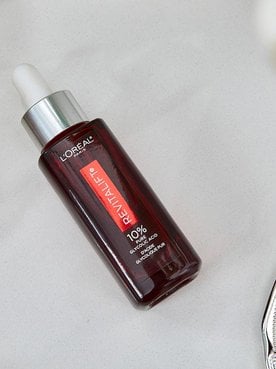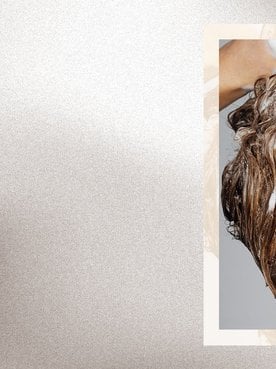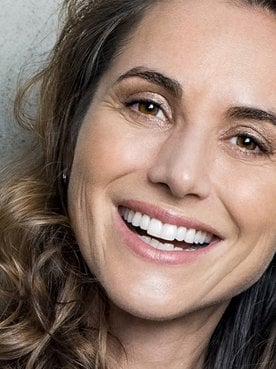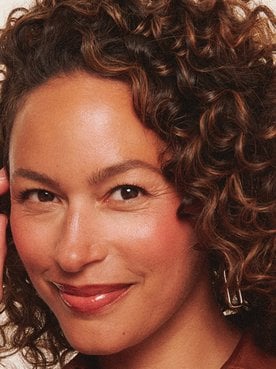Balayage highlights have long been popular amongst brunettes looking to brighten their mane without committing to an all-over dye job. Less well-known (but equally impactful) is reverse balayage, a coloring technique designed to add depth and dimension to the hair.
Unlike balayage or traditional highlights, which require lightening individual strands, reverse balayage doesn’t typically involve the use of bleach. This makes it an especially appealing option for those seeking to tweak their hair color without incurring unnecessary damage. Ahead, we’re breaking down what this hair coloring technique is, how your colorist can use reverse balayage to blend your roots, and how to maintain your reverse balayage for fewer trips to the salon.
What Is Reverse Balayage?
Reverse balayage is a lowlighting technique that involves placing darker streaks throughout your strands to create a more dimensional—and in many cases, noticeably deeper—hair color. Because the color added is typically a medium to dark shade of brown rather than light blonde, the technique is sometimes referred to as brunette balayage.
Like classic balayage, the lowlights are hand-painted on in a sweeping motion, usually starting a few inches down from the root. The end result is a lived-in, natural-looking color that tends to require fewer touch-ups than classic highlights or lowlights.
Reverse Balayage vs. Balayage: What’s The Difference?
There are two main differences between traditional balayage and reverse balayage: the type of dye (or dyes) used to achieve the look and the overall outcome. We’ll break down both below.
1. The coloring products used
Like traditional highlights, classic balayage involves using bleach to lighten specific strands of hair. After bleaching, the hair may be colored with a permanent hair dye to achieve the desired shade of blonde. Toner may also be applied to help counteract brassiness from lightening the hair.
Brown balayage, on the other hand, doesn’t require bleaching the hair at all. Instead, your colorist will hand-paint lowlights onto your hair with a permanent or semi-permanent hair dye in a shade slightly deeper than your current color.
2. The overall outcome
Though they’re similar in name, balayage and reverse balayage produce very different end results. As mentioned, the former usually involves brightening the hair with light brown or blonde highlights. Traditional balayage can be subtle or bold, but in either case, the technique results in an overall lighter hair color.
Reverse balayage, by contrast, involves incorporating medium to dark brown lowlights throughout the mane to create a richer, darker hair color. The technique can help deepen a bright blonde base or blend dark roots with lightened hair for more seamless regrowth. Reverse balayage on dark hair can also help add dimension to your existing hair color.
What Are The Benefits of Reverse Balayage?
Reverse balayage is a great hair coloring option for those seeking to darken their hair without completely abandoning their base color—or committing to an all-over dye job. Brunette balayage on brown hair also tends to be low-maintenance, natural-looking, and less damaging than traditional highlights.
Low-maintenance
Unless you’re going for an intentionally rooted look, traditional highlights generally require touch-ups every six to eight weeks. With reverse balayage, the lowlights start further down from the root, so regrowth isn’t as noticeable. It’s therefore among the most low-maintenance hair color options—depending on how quickly your hair grows, you may be able to extend your time between touch-ups to a couple of months or more.
Natural-looking
By darkening certain sections of the hair, reverse balayage creates contrast that adds visual interest and enhances and works with your natural hair color. It’s an excellent option for those who want to transition from a lighter to a darker hair color gradually, without the commitment of fully darkening the entire head of hair. And because the added color tends to only be a shade or two darker than your base, reverse balayage results in a natural-looking depth that doesn’t make your hair appear obviously “dyed.”
Versatile
Reverse balayage can easily be adapted for nearly any hair color. If you’re a blonde, you can ask your colorist for a light brown balayage to create subtle depth and dimension. Warm hues like golden brown are flattering for those with warmer blonde hair, while ashier browns flatter cool blondes beautifully. To balayage brown hair, you can use a richer brown shade, like chocolate or espresso, to add subtle depth. The technique even works well for redheads—your colorist will simply add a richer red or reddish-brown lowlights throughout your hair for a flattering tonal effect.
Less damaging
Traditional balayage, as mentioned, involves bleaching the hair to lighten individual strands. As anyone who has lightened their hair before likely knows, bleach can be damaging (even in the hands of a professional colorist). Reverse balayage eliminates the need to use bleach or lightener, which may make it a gentler, less damaging approach than standard highlights.
Is Reverse Balayage Right for You?
Almost anyone can get reverse balayage, but it tends to especially popular option amongst blondes looking to deepen their existing color. The brunette balayage helps blend regrowth with your lighter ends to create a more natural-looking color and extend the time between touch-ups. That said, it’s also a great option for brunettes and redheads seeking a subtle but impactful hair color change. Overall, it’s worth considering if you want to darken your current hair color without committing to an all-over dye job.
How To Care for Reverse Balayage Hair
While reverse balayage is lower-maintenance than traditional highlights, you’ll still want to ensure you’re taking proper care of your hair to keep your lowlights looking vibrant and healthy. Here are a few tips to keep in mind.
1. Use color-safe products
After any coloring service—whether a professional dye job or a DIY transformation—it’s a good idea to update your routine with color-safe products to help preserve your new hue. The L’Oréal Paris Elvive Color Vibrancy Protecting Shampoo and L’Oréal Paris Elvive Color Vibrancy Protecting Conditioner are great options, as they’re designed to deliver shine and color protection for up to eight weeks.
If your hair is damaged from previous color services, consider using the L’Oréal Paris EverPure Sulfate-Free Bond Repair Shampoo and the L’Oréal Paris EverPure Sulfate-Free Bond Repair Conditioner. The color-safe duo helps reinforce weakened hair from the inside out to promote stronger, smoother-looking strands. You can learn more about the repairative lineup and how it works here.
Shop the Products
2. Try a toning gloss
If you find your hair color beginning to lose its vibrancy, consider reaching for a hair gloss. These products add a subtle wash of color and help promote shinier, healthier-looking hair. L’Oréal Paris Le Color Gloss One Step In-Shower Toning Gloss is an incredible option for mirroring the salon color touch-up toning experience right at home. In just one step, it gives the hair a boost of shine and conditioning while enhancing its color and tone with a sheer wash of color. Choose a shade that closely aligns with your existing hue or pick the clear option for shine and deep conditioning sans any added pigment.
3. Protect your mane
Heat styling is sometimes hard to avoid, but doing it frequently can damage your strands and make your color fade more rapidly. If you do need to blow-dry, curl, or flat iron your hair, make sure you protect your strands with a high-quality heat protectant. Try the L’Oréal Paris EverPure Sulfate-Free Blow Dry Primer for 48 HR Frizz Control. The leave-in treatment helps smooth the hair, boosts shine, and protects against temperatures up to 450 degrees Fahrenheit. The L’Oréal Paris Elvive Dream Lengths Heat Slayer Leave-In is a great pick as well, particularly if you plan to straighten your hair. Remember to take breaks between heat styling when you can to help preserve your hair’s healthy look and feel.
Shop the Products
Next Up: 22 Ways To Rock Highlights on Dark Hair
Photo credit: JK’s Cuts and Colors, IG/@jkscutscolours

